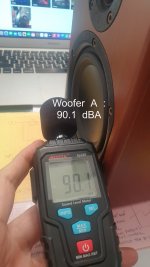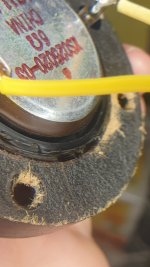Great find Chris! Much appreciated. Tells me I need to polish up on my diagram tracing by quite a bit.I found the crossover schematic @ http://blog.livedoor.jp/tsdoctor/archives/4553915.html
View attachment 1056570
I did some tests today. All measurements are done without the crossovers attached. Barebones speakers only. These are the results (refer to pictures):Can you please remind me have you heard anything from the two tweeters when you momentarily connect a 1,5 V battery across the tweeter terminals?
If you haven't heard anything from the tweeter i am concerned they may be the issue?
Both tweeters are giving out a nice high pitch tone at 3 kHz input from my signal generator. Loudness is at around 74.5 dBA for both speakers. Both woofers are louder at around 90 dBA. Is this good news or are the tweeters due for a ferrofluid change?
BTW, before removing the film capacitor for measurement, I already tested it in-circuit and the readings were already wonky (ya, I know its taboo to read caps while in-circuit). And I used several meters to get a measurement as I was rather surprised at the low uF. And this is for the first speaker. As for the second speaker, the reading is even wonkier. In circuit, I am getting a reading of 13.4 uF for a rated 4.7 uF capacitor. Can desoldering the film cap really damage it that much?
Attachments
Last edited:
It's unclear whether this is the reason for your discrepancy but yes, plastic melts readily especially if you are not getting positive heat transfer for a quick operation. A dirty tip among other things can require a prolonged application of heat that can travel along the lead and cause damage.Can desoldering the film cap really damage it that much?
The tweeter output level seems to be way down, So with a working filter with replaced components it will be even lower output.
But we do not know how accurate or possibly directional your mic is, so it may be worth testing the woofer at 3Khz and double check your data. I doubt if a small woofer will be down by less than 6dB or so at 3 kKHz, it may be flat or even have a bump. So if the numbers stay the same as your 90 and 76 results, it does suggest the tweeter. I wonder if the does come apart easily for dome replacement. If you can dismantle your originals ferrofluid should be around £20 or so so.
Or, if the tweeter doesn't seem to be able to be disassembled it may be time to look for a suitable peerless or SB acoustics tweeter that fits and has the same basic 25mm dome and impedance and fit it as a replacement and play with the resistor values to make it match.
You have some tools that allow you to measure output levels so you should be able to get a workable result.
Parts Express, Willys hif, Soundimports or your favourite speaker supplier. You can get some nice tweeters for less than £25 each,
But we do not know how accurate or possibly directional your mic is, so it may be worth testing the woofer at 3Khz and double check your data. I doubt if a small woofer will be down by less than 6dB or so at 3 kKHz, it may be flat or even have a bump. So if the numbers stay the same as your 90 and 76 results, it does suggest the tweeter. I wonder if the does come apart easily for dome replacement. If you can dismantle your originals ferrofluid should be around £20 or so so.
Or, if the tweeter doesn't seem to be able to be disassembled it may be time to look for a suitable peerless or SB acoustics tweeter that fits and has the same basic 25mm dome and impedance and fit it as a replacement and play with the resistor values to make it match.
You have some tools that allow you to measure output levels so you should be able to get a workable result.
Parts Express, Willys hif, Soundimports or your favourite speaker supplier. You can get some nice tweeters for less than £25 each,
I'll have to remember to put a heat sinking copper alligator clip to the cap's legs next time before soldering. Was not aware that film caps were that sensitive to heat! Many thanks for your inputs, Allen. Much appreciated.It's unclear whether this is the reason for your discrepancy but yes, plastic melts readily especially if you are not getting positive heat transfer for a quick operation. A dirty tip among other things can require a prolonged application of heat that can travel along the lead and cause damage.
But we do not know how accurate or possibly directional your mic is, so it may be worth testing the woofer at 3Khz and double check your data. I doubt if a small woofer will be down by less than 6dB or so at 3 kKHz, it may be flat or even have a bump. So if the numbers stay the same as your 90 and 76 results, it does suggest the tweeter.
I'll conduct more sound level tests later on to verify my data and confirm if the dBA discrepancy is really that great. Like u said, the sound level tester mike may be directional. Shouldn't and will not leave it to chance. Is there a tutorial where I can learn to match the resistance to new tweeters in case things go the other way? I'm really new at this and don't want to mess up too badly.
Everyone here has been really helpful so far and I've learnt a lot from this great community.
I'll probably take the path of changing the ferrofluid first. If I bungle that up ( and I suspect I will ), the next thing to do would be to purchase some replacement tweeters. At least I got some practice with ferrofluid out of this. Never thought I'd fall into this rabbit hole!
dBA weighting around 3Khz should be ok, but also as another check it might be trying on the dbC measurement position to confirm.
If the tweeter is assembled using screws you you should have a reasonable chance of dismantling it.
Once you can actually see the dome and voice coil gap you will have to look and find the voice coil connections. They will probably be very thin and it maybe stuck or secured to the faceplate which will be a pain.
Possibly you could use a hair dryer or heat gun on low to try and unstick the wires. You will have to work on the adhesive as the the wires will not take any major abuse. To unsolder the wires You will need your newly cleaned solder tip fluxed and with a nice thin coating of solder very quickly unsolder the wires also be aware if the terminal is mounted in a a plastic moulding you need to be quick so as to prevent the heat deforming the terminal mount in the plastic.
Take your time and photograph it with your phone so you have a record for assembly. Some isopropyl alcohol and some tissue or thin paper even card should help you get the old stuff out. If stuck you can attach pictures of the problem.
Take your time, and you should get the result
If the tweeter is assembled using screws you you should have a reasonable chance of dismantling it.
Once you can actually see the dome and voice coil gap you will have to look and find the voice coil connections. They will probably be very thin and it maybe stuck or secured to the faceplate which will be a pain.
Possibly you could use a hair dryer or heat gun on low to try and unstick the wires. You will have to work on the adhesive as the the wires will not take any major abuse. To unsolder the wires You will need your newly cleaned solder tip fluxed and with a nice thin coating of solder very quickly unsolder the wires also be aware if the terminal is mounted in a a plastic moulding you need to be quick so as to prevent the heat deforming the terminal mount in the plastic.
Take your time and photograph it with your phone so you have a record for assembly. Some isopropyl alcohol and some tissue or thin paper even card should help you get the old stuff out. If stuck you can attach pictures of the problem.
Take your time, and you should get the result
After dismantling the tweeter, more questions start to arise.
I input a 3kHz signal at 3V and as usual got a nice tone. Then I varied the voltage up to 10V and naturally, the tone got louder with each unit voltage step upwards. The tweeter seems to react normally just that when compared with the woofer (with both tested at 3kHz and 3V), we have a 15dBA difference, which is excessive.
Take a look at the tweeter construction. On the outer circumference of the metal cap, there is a brown plastic-like hardened glue which I think is encasing the voice coil. It seems to be rather difficult to remove that without damaging the insides. Denon certainly spared no expense in the choice of tweeters. Seems like a task I'd rather not undertake as I'm sure to mess things up royally. What do you think? Go or no go?
I input a 3kHz signal at 3V and as usual got a nice tone. Then I varied the voltage up to 10V and naturally, the tone got louder with each unit voltage step upwards. The tweeter seems to react normally just that when compared with the woofer (with both tested at 3kHz and 3V), we have a 15dBA difference, which is excessive.
Take a look at the tweeter construction. On the outer circumference of the metal cap, there is a brown plastic-like hardened glue which I think is encasing the voice coil. It seems to be rather difficult to remove that without damaging the insides. Denon certainly spared no expense in the choice of tweeters. Seems like a task I'd rather not undertake as I'm sure to mess things up royally. What do you think? Go or no go?
Attachments
Can you show the front plate. Does it have a stuck on plastic trim ring, which again carefully you could try to pry off, and see if there are three or four screws underneath.
I am not sure what the brown material is, but the black mastic type stuff may hold the tweeter on the faceplate assy, kindly can you post full view of the back and also the area around the terminals in the hope of providing more clues?
I am not sure what the brown material is, but the black mastic type stuff may hold the tweeter on the faceplate assy, kindly can you post full view of the back and also the area around the terminals in the hope of providing more clues?
What do you think? Go or no go?
In the event of having to replace the tweeter, it would be useful to know its faceplate diameter and the diameter of its mounting hole.
You wouldn't want to spend too much on a replacement, and Monacor make affordable and similar looking tweeters.
For example (66mm diameter faceplate): https://willys-hifi.com/collections/monacor-tweeters/products/monacor-dt-25n-tweeter
Attachments
- Home
- Loudspeakers
- Multi-Way
- Request for help : Denon M37 speaker crossover parts replacement










